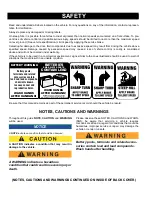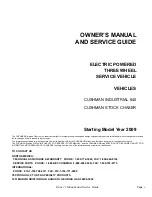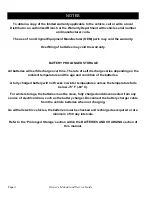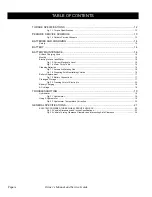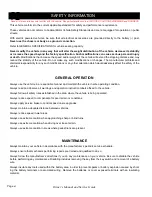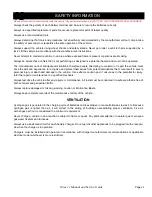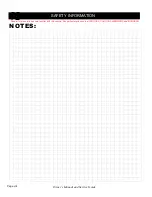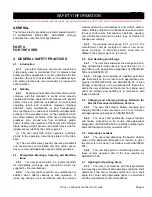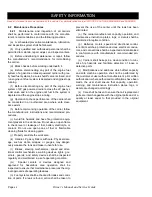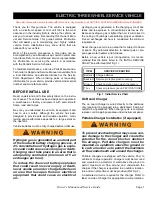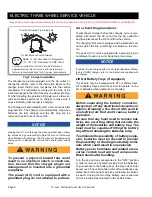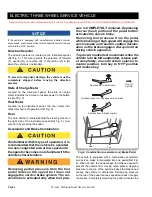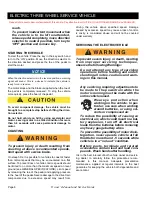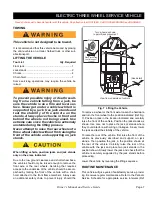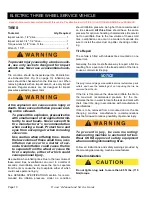
SAFETY INFORMATION
Page ix
Owner’s Manual and Service Guide
Read all of manual to become familiar with this vehicle. Pay particular attention to all NOTICES, CAUTIONS,WARNINGS and DANGERS.
GENERAL
The following text is provided as recommended by part II
of ASME/ANSI B56.8-1988. CUSHMAN strongly
endorses the contents of this specification.
PART II
FOR THE USER
4 GENERAL SAFETY PRACTICES
4.1
Introduction
4.1.1
Like other machines, carriers can cause injury
if improperly used or maintained. Part II contains broad
safety practices applicable to carrier operations. Before
operation, the user shall establish such additional spe-
cific safety practices as may reasonably be required for
safe operation.
4.2
Stability
4.2.1
Experience has shown that this vehicle, which
complies with this standard, is stable when properly
operated and when operated in accordance with specific
safety rules and practices established to meet actual
operating terrain and conditions. However, improper
operation, faulty maintenance, or poor housekeeping
may contribute to a condition of instability and defeat the
purpose of the standard. Some of the conditions which
may affect stability are failure of the user to follow safety
practices; also, ground and floor conditions, grade,
speed, loading, the operation of the carrier with improper
loads, battery weight, dynamic and static forces, and the
judgement exercised by the carrier operator.
(a) The user shall train carrier operators to adhere
strictly to the operating instructions stated in this Stan-
dard.
(b) The user shall survey specific operating conditions
and environment, and establish and train carrier opera-
tors to comply with additional, specific safety practices.
4.3
Nameplates, Markings, Capacity, and Modifica-
tions
4.3.1
The user shall maintain in a legible condition
all nameplates, warnings, and instructions which are
supplied by the manufacturer.
4.3.2
The user shall not perform any modification or
addition which affects capacity or safe operation, or
make any change not in accordance with the owner’s
manual without the manufacturer’s prior written authori-
zation. Where authorized modifications have been made,
the user shall ensure that capacity, operation, warning,
and maintenance instruction plates, tags, or decals are
changed accordingly.
4.3.3
As required under paras. 4.3.1 or 4.3.2, the
manufacturer shall be contacted to secure new name-
plates, warnings, or instructions which shall then be
affixed in their proper place on the carrier.
4.4
Fuel Handling and Storage
4.4.1
The user shall supervise the storage and han-
dling of liquid fuels (when used) to be certain that it is in
accordance with appropriate paragraphs of ANSI/NFPA
505 and ANSI/NFPA 30.
4.4.2
Storage and handling of liquefied petroleum
gas fuels shall be in accordance with appropriate para-
graphs of ANSI/NFPA 505 and ANSI/NFPA 58. If such
storage or handling is not in compliance with these stan-
dards, the user shall prevent the carrier from being used
until such storage and handling is in compliance with
these standards.
4.5
Changing and Charging Storage Batteries for
Electric Personnel and Burden Carriers
4.5.1
The user shall require battery changing and
charging facilities and procedures to be in accordance
with appropriate paragraphs of ANSI/NFPA 505.
4.5.2
The user shall periodically inspect facilities
and review procedures to be certain that appropriate
paragraphs of ANSI/NFPA 505, are strictly complied with,
and shall familiarize carrier operators with it.
4.6
Hazardous Locations
4.6.1
The user shall determine the hazard classifi-
cation of the particular atmosphere or location in which
the carrier is to be used in accordance with ANSI/NFPA
505.
4.6.2
The user shall permit in hazardous areas only
those carriers approved and of the type required by
ANSI/NFPA 505.
4.7
Lighting for Operating Areas
4.7.1
The user, in accordance with his responsibility
to survey the environment and operating conditions, shall
determine if the carrier requires lights and, if so, shall
equip the carrier with appropriate lights in accordance
with the manufacturer’s recommendations.


